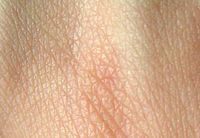
Photo from wikipedia
Graphical abstract Figure. No caption available. ABSTRACT Ultraviolet A (UVA) irradiation is toxic to skin as it penetrates deep into the dermis and damages cellular components through excessive reactive oxygen… Click to show full abstract
Graphical abstract Figure. No caption available. ABSTRACT Ultraviolet A (UVA) irradiation is toxic to skin as it penetrates deep into the dermis and damages cellular components through excessive reactive oxygen species (ROS) production, which accelerates photoaging and skin cancer. We evaluated the dermato‐protective efficacies of zerumbone (natural sesquiterpene of Zingiber zerumbet) in UVA‐irradiated human skin keratinocyte (HaCaT) cells and mouse epidermis. Zerumbone pretreatment (2–10 &mgr;M) substantially suppressed UVA (15 J/cm2)‐induced HaCaT cell death and lactate dehydrogenase release in a dose‐dependent manner. UVA‐induced excessive ROS production, DNA single‐strand breaks, apoptotic DNA fragmentation and a dysregulated Bax/Bcl‐2 ratio were remarkably reversed by zerumbone in keratinocytes. Zerumbone‐mediated cytoprotective properties were associated with increased nuclear translocation of nuclear factor‐E2‐related factor‐2 (Nrf2) and elevated antioxidant response element (ARE) luciferase activity. Activation of Nrf2/ARE signaling was accompanied by induction of heme oxygenase‐1 (HO‐1) and &ggr;‐glutamyl cysteine ligase (&ggr;‐GCLC) genes in zerumbone‐treated keratinocytes. Zerumbone‐induced Nrf2 transcriptional activation was mediated by the p38 MAPK, PI3K/AKT and PKC signaling cascades. Notably, silencing of Nrf2 (siRNA transfection) significantly diminished zerumbone‐mediated cytoprotective effects, as evidenced by impaired antioxidant genes, uncontrolled ROS/apoptotic DNA fragmentation and keratinocytes death, following UVA irradiation. In vivo evidence demonstrated that zerumbone treatment to nude mice (55 and 110 &mgr;g/day) significantly ameliorated UVA (15 J/cm2/every 2‐day/14‐day) cytotoxicity via increased nuclear localization of Nrf2 and Nrf2‐dependent antioxidant genes (HO‐1 and &ggr;‐GCLC) in UVA‐treated skin tissues. Our findings emphasized the significance of Nrf2/ARE‐signaling in zerumbone‐mediated induction of antioxidant genes against UVA‐toxicity. The molecular evidence suggests zerumbone can be a natural medicine to treat/prevent UVA‐induced skin damage/photoaging.
Journal Title: Biochemical Pharmacology
Year Published: 2018
Link to full text (if available)
Share on Social Media: Sign Up to like & get
recommendations!